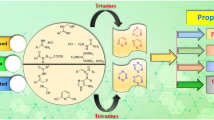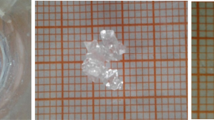Abstract
The in vitro antimicrobial activity of Fe(III) and Ga(III) complexes with N'-(2,3-dihydroxy-phenylmethylidene)-3-pyridinecarbohydrazide (H2L1), N'-(2,4-dihydroxy-phenyl-methylidene)-3-pyridinecarbohydrazide (H2L2), N'-(2,5-dihydroxy-phenylmethylidene)-3-pyridinecarbohydrazide (H2L3), N'-(2-hydroxy-3-methoxyphenyl-methylidene)-3-pyridine-carbohydrazide (H2L4), N'-(2-hydroxy-4-methoxyphenylmethyl-idene)-3-pyridine-carbohydrazide (H2L5), and N'-(2-hydroxy-5-methoxyphenylmethylidene)-3-pyridinecarbo-hydrazide (H2L6) toward several Gram-positive strains of Staphylococcus aureus, a Gram-negative strain of Escherichia coli, and a yeast Candida albicans were investigated. Fe(III)-complexes do not possess antimicrobial activity against all tested strains at concentrations up to 10 mg mL–1. Ga(III) complexes with dihydroxy derivatives showed selective activity, while the broadest range of antibacterial and antifungal activities was observed for complex with 2-hydroxy-3-methoxy-derivative, ligand H2L5. In addition, the coordination properties of ligands H2L1–H2L3 in solution were investigated by UV–Vis spectroscopy. The stability constants (logK) for Ga(III)-H2L 1:1 complexes in MeOH/H2O 1/1 at pH 2.52 were determined, and amounted to 5.8, 5.68, and 4.7, respectively. Detailed characterization of complexes was performed by high-resolution mass spectrometry. The fragmentation pathways for dimer [Fe2(L1)2]2+, [Fe(HL)2]+, [Ga(HL2)2]+ and adduct ions are given. The comparison with analogue Ga(III) and Fe(III) complexes with compounds H2L4–H2L6 was made as well.
Graphical abstract









Similar content being viewed by others
References
Murray CJ, Ikuta KS, Sharara F, Swetschinski L, Robles Aguilar G, Gray A, Han C, Bisignano C, Rao P, Wool E, Johnson SC, Browne AJ, Chipeta MG, Fell F, Hackett S, Haines-Woodhouse G, Kashef Hamadani BH, Kumaran EAP, McManigal B, Agarwal R, Akech S, Albertson S, Amuasi J, Andrews J, Aravkin A, Ashley E, Bailey F, Baker S, Basnyat B, Bekker A, Bender R, Bethou A, Bielicki J, Boonkasidecha S, Bukosia J, Carvalheiro C, Castañeda-Orjuela C, Chansamouth V, Chaurasia S, Chiurchiù S, Chowdhury F, Cook AJ, Cooper B, Cressey TR, Criollo-Mora E, Cunningham M, Darboe S, Day NPJ, De Luca M, Dokova K, Dramowski A, Dunachie SJ, Eckmanns T, Eibach D, Emami A, Feasey N, Fisher-Pearson N, Forrest K, Garrett D, Gastmeier P, Giref AZ, Greer RC, Gupta V, Haller S, Haselbeck A, Hay SI, Holm M, Hopkins S, Iregbu KC, Jacobs J, Jarovsky D, Javanmardi F, Khorana M, Kissoon N, Kobeissi E, Kostyanev T, Krapp F, Krumkamp R, Kumar A, Kyu HH, Lim C, Limmathurotsakul D, Loftus MJ, Lunn M, Ma J, Mturi N, Munera-Huertas T, Musicha P, Mussi-Pinhata MM, Nakamura T, Nanavati R, Nangia S, Newton P, Ngoun C, Novotney A, Nwakanma D, Obiero CW, Olivas-Martinez A, Olliaro P, Ooko E, Ortiz-Brizuela E, Peleg AY, Perrone C, Plakkal N, Ponce-de-Leon A, Raad M, Ramdin T, Riddell A, Roberts T, Robotham JV, Roca A, Rudd KE, Russell N, Schnall J, Scott JAG, Shivamallappa M, Sifuentes-Osornio J, Steenkeste N, Stewardson AJ, Stoeva T, Tasak N, Thaiprakong A, Thwaites G, Turner C, Turner P, van Doorn HR, Velaphi S, Vongpradith A, Vu H, Walsh T, Waner S, Wangrangsimakul T, Wozniak T, Zheng P, Sartorius B, Lopez AD, Stergachis A, Moore C, Dolecek C, Naghavi M (2022) Global burden of bacterial antimicrobial resistance in 2019: a systematic analysis. Lancet 399:629–655. https://doi.org/10.1016/S0140-6736(21)02724-0
O’Neill J (2016) Tackling Drug-resistant infections globally: final report and recommendations. https://apo.org.au/node/63983
World Health Organization (2020) Antibacterial agents in clinical and preclinical development: an overview and analysis. Available at https://www.who.int/publications/i/item/9789240021303. Accessed 17 Mar 2022
Blaskovich MAT (2020) Challenges and opportunities in antibiotic discovery and development. ACS Infect Dis 6:1286–1288. https://doi.org/10.1021/acsinfecdis.0c00331
Beyer P, Paulin S (2020) The antibacterial research and development pipeline needs urgent solutions. ACS Infect Dis 6:1289–1291. https://doi.org/10.1021/acsinfecdis.0c00044
Kong Q, Yang Y (2021) Recent advances in antibacterial agents. Bioorg Med Chem Lett 35:127799. https://doi.org/10.1016/j.bmcl.2021.127799
Lemire JA, Harrison JJ, Turner RJ (2013) Antimicrobial activity of metals: mechanisms, molecular targets and applications. Nat Rev Microbiol 11:371–384. https://doi.org/10.1038/nrmicro3028
Frei A, Zuegg J, Elliott AG, Baker M, Braese S, Brown C, Chen F, Dowson CG, Dujardin G, Jung N, King AP, Mansour AM, Massi M, Moat J, Mohamed HA, Renfrew AK, Rutledge PJ, Sadler PJ, Todd MH, Willans CE, Wilson JJ, Cooper MA, Blaskovich MAT (2020) Metal complexes as a promising source for new antibiotics. Chem Sci 11:2627–2639. https://doi.org/10.1039/C9SC06460E
Evans A, Kavanagh KA (2021) Evaluation of metal-based antimicrobial compounds for the treatment of bacterial pathogens. J Med Microbiol 70:001363. https://doi.org/10.1099/jmm.0.001363
Nairz M, Weiss G (2020) Iron in infection and immunity. Mol Aspects Med 75:100864. https://doi.org/10.1016/j.mam.2020.100864
Chitambar CR (2016) Gallium and its competing roles with iron in biological systems. Biochim Biophys Acta - Mol Cell Res 1863:2044–2053. https://doi.org/10.1016/j.bbamcr.2016.04.027
Gugala N, Chatfield-Reed K, Turner RJ, Chua G (2019) Using a chemical genetic screen to enhance our understanding of the antimicrobial properties of gallium against Escherichia coli. Genes 10:34. https://doi.org/10.3390/genes10010034
Goss CH, Kaneko Y, Khuu L, Anderson GD, Ravishankar S, Aitken ML, Lechtzin N, Zhou G, Czyz DM, McLean K, Olakanmi O, Shuman HA, Teresi M, Wilhelm E, Caldwell E, Salipante SJ, Hornick DB, Siehnel RJ, Becker L, Britigan BE, Singh PK (2018) Gallium disrupts bacterial iron metabolism and has therapeutic effects in mice and humans with lung infections. Sci Transl Med 10:eaat7520. https://doi.org/10.1126/scitranslmed.aat7520
Pandey A, Savino C, Ahn SH, Yang Z, Van Lanen SG, Boros E (2019) Theranostic gallium siderophore ciprofloxacin conjugate with broad spectrum antibiotic potency. J Med Chem 62:9947–9960. https://doi.org/10.1021/acs.jmedchem.9b01388
Kelson AB, Carnevali M, Truong-Le V (2013) Gallium-based anti-infectives: targeting microbial iron-uptake mechanisms. Curr Opin Pharmacol 13:707–716. https://doi.org/10.1016/j.coph.2013.07.001
Chitambar CR (2010) Medical applications and toxicities of gallium compounds. Int J Environ Res Public Health 7:2337–2361. https://doi.org/10.3390/ijerph7052337
Li F, Liu F, Huang K, Yang S (2022) Advancement of gallium and gallium-based compounds as antimicrobial agents. Front Bioeng Biotechnol. https://doi.org/10.3389/fbioe.2022.827960
Popiołek Ł (2017) Hydrazide-hydrazones as potential antimicrobial agents: overview of the literature since 2010. Med Chem Re 26:287–301. https://doi.org/10.1007/s00044-016-1756-y
Polović S, Ljoljić Bilić V, Budimir A, Kontrec D, Galić N, Kosalec I (2019) Antimicrobial assesment of aroylhydrazone derivatives. Acta Pharm 69:277–285. https://doi.org/10.2478/acph-2019-0020
Iliev I, Kontrec D, Detcheva R, Georgieva M, Balacheva A, Galić N, Pajpanova T (2019) Cancer cell growth inhibition by aroylhydrazone derivatives. Biotechnol Biotechnol Equip 33:756–763. https://doi.org/10.1080/13102818.2019.1608302
Shakdofa MME, Shtaiwi MH, Morsy N, Abdel-rassel TMA (2014) Metal complexes of hydrazones and their biological, analytical and catalytic applications: a review. Main Group Chem 13:187–218. https://doi.org/10.3233/MGC-140133
Hruskova K, Kovarikova P, Bendova P, Haskova P, Mackova E, Stariat J, Vavrova A, Vavrova K, Simunek T (2011) Synthesis and initial in vitro evaluations of novel antioxidant aroylhydrazone iron chelators with increased stability against plasma hydrolysis. Chem Res Toxicol 24:290–302. https://doi.org/10.1021/tx100359t
Hakobyan S, Rzhepishevska O, Björn E, Boily J-F, Ramstedt M (2016) Influence of chelation strength and bacterial uptake of gallium salicylidene acylhydrazide on biofilm formation and virulence of Pseudomonas aeruginosa. J Inorg Biochem 160:24–32. https://doi.org/10.1016/j.jinorgbio.2016.04.010
Benković T, Kenđel A, Parlov-Vuković J, Kontrec D, Chiş V, Miljanić S, Galić N (2018) Multiple dynamics of aroylhydrazone induced by mutual effect of solvent and light - spectroscopic and computational study. J Mol Liq 255:18–25. https://doi.org/10.1016/j.molliq.2018.01.158
Benković T, Kenđel A, Parlov-Vuković J, Kontrec D, Chiş V, Miljanić S, Galić N (2018) Aromatic hydrazones derived from nicotinic acid hydrazide as fluorimetric pH sensing molecules: Structural analysis by computational and spectroscopic methods in solid phase and in solution. Spectrochim Acta A Mol Biomol Spectrosc 190:259–267. https://doi.org/10.1016/j.saa.2017.09.038
Stražić D, Benković T, Gembarovski D, Kontrec D, Galić N (2014) Comprehensive ESI-MS and MS/MS analysis of aromatic hydrazones derived from nicotinic acid hydrazide. Int J Mass Spectrom 371:54–64. https://doi.org/10.1016/j.ijms.2014.07.036
Benković T, Kontrec D, Tomišić V, Budimir A, Galić N (2016) Acid-base properties and kinetics of hydrolysis of aroylhydrazones derived from nicotinic acid hydrazide. J Sol Che 45:1227–1245. https://doi.org/10.1007/s10953-016-0504-8
Kenđel A, Miljanić S, Kontrec D, Soldin Ž, Galić N (2020) Copper(II) complexes of aroylhydrazones: preparation and structural characterization. J Mol Struct 1207:127783. https://doi.org/10.1016/j.molstruc.2020.127783
Benković T, Kontrec D, Kazazić S, Chiş V, Miljanić S, Galić N (2020) Diverse coordination of aroylhydrazones toward iron(III) in solid state and in solution: spectrometric, spectroscopic and computational study. Mol Divers 24:1253–1263. https://doi.org/10.1007/s11030-019-09989-6
Pocrnić M, Kontrec D, Miljanić S, Soldin Ž, Budimir A, Galić N (2021) Gallium(III) complexes of aroylhydrazones derived from nicotinic acid hydrazide in solid state and in solution. J Mol Struct 1227:129564. https://doi.org/10.1016/j.molstruc.2020.129564
Churchill DG (2006) Chemical structure and accidental explosion risk in the research laboratory. J Chem Educ 83:1798. https://doi.org/10.1021/ed083p1798
European Pharmacopoeia Commission (2005) European Pharmacopoeia, 5th edn. Council of Europe, Strasbourg, France, pp 188–191
European Committee for Antimicrobial Susceptibility Testing (EUCAST) of the European Society for Clinical Microbiology and Infectious Diseases (ESCMID). EUCAST Discussion Document E. Dis 5.1 (2003) Determination of minimum inhibitory concentrations (MICs) of antibacterial agents by broth dilution. Clin Microbiol Infec 9:1–7. https://doi.org/10.1046/j.1469-0691.2003.00790.x
Arendrup MC, Meletiadis J, Mouton JW, Lagrou K, Hamal P, Guinea J (2017) Subcommittee on Antifungal Susceptibility Testing of the ESCMID European Committee for Antimicrobial Susceptibility Testing . EUCAST definitive document E.DEF 7.3.1. Method for the determination of broth dilution minimum inhibitory concentrations of antifungal agents for yeasts. http://www.eucast.org/fileadmin/src/media/PDFs/EUCAST_files/AFST/Files/EUCAST_E_Def_7_3_1_Yeast_testing__definitive.pdf
Lambert RJ, Pearson J (2000) Susceptibility testing: accurate and reproducible minimum inhibitory concentration (MIC) and non-inhibitory concentration (NIC) values. J Appl Microb 88:784–790. https://doi.org/10.1046/j.1365-2672.2000.01017.x
Beck S (2021) Fragmentation behavior of EDTA complexes under different activation conditions. J Mass Spectrom 56:4775. https://doi.org/10.1002/jms.4775
Manman H, Weilan C, Zhimin L, Liang P, Lixia H, Min C (2019) ESI-TOF MS analysis of complexes formed between quercetin and five metal ions in hot water and a study into their DNA cleavage activity. J Inorg Biochem 195:13–19. https://doi.org/10.1016/j.jinorgbio.2019.03.004
Nikolova-Mladenova B, Angelova S, Momekov G (2022) Gallium (III) complexes with 5-Bromosalicylaldehyde benzoylhydrazones: in silico studies and in vitro cytotoxic activity. Molecules 27:5493. https://doi.org/10.3390/molecules27175493
Antunes LCS, Imperi F, Minandri F, Visca P (2012) In vitro and in vivo antimicrobial activities of gallium nitrate against multidrug-resistant Acinetobacter baumannii. Antimicrob Agents Chemother 56:5961–5970. https://doi.org/10.1128/AAC.01519-12
Acknowledgements
This work was supported by the Croatian Science Foundation (project IP-2014-09-4841) and project CIuK co-financed by the Croatian Government and the European Union through the European Regional Development Fund-Competitiveness and Cohesion Operational Programme (Grant KK.01.1.1.02.0016.).
Author information
Authors and Affiliations
Corresponding authors
Ethics declarations
Conflict of interest
The authors declare that they have no conflict of interest.
Additional information
Publisher's Note
Springer Nature remains neutral with regard to jurisdictional claims in published maps and institutional affiliations.
Supplementary Information
Below is the link to the electronic supplementary material.
Rights and permissions
Springer Nature or its licensor holds exclusive rights to this article under a publishing agreement with the author(s) or other rightsholder(s); author self-archiving of the accepted manuscript version of this article is solely governed by the terms of such publishing agreement and applicable law.
About this article
Cite this article
Klarić, D., Pocrnić, M., Lež, D. et al. Search for new antimicrobials: spectroscopic, spectrometric, and in vitro antimicrobial activity investigation of Ga(III) and Fe(III) complexes with aroylhydrazones. J Biol Inorg Chem 27, 715–729 (2022). https://doi.org/10.1007/s00775-022-01967-y
Received:
Accepted:
Published:
Issue Date:
DOI: https://doi.org/10.1007/s00775-022-01967-y




